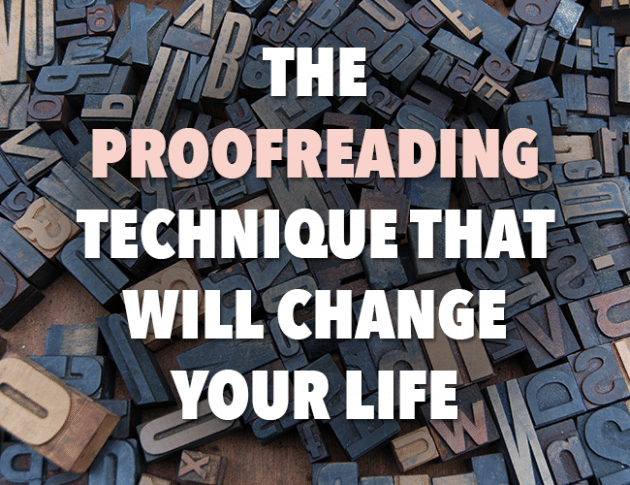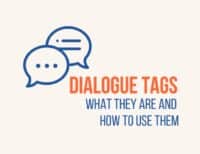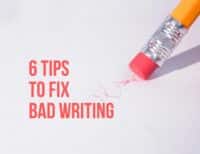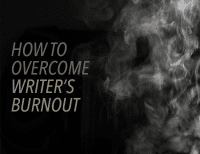You've heard over and over again that the most important thing to do as a writer is to write. Write when you don't want to. Write when you do want to. When you don't know what to write, write anything.
But there are two sides to the writing coin. There is writing, and there is editing. In this post, I'm going to share a proofreading technique I learned recently that is changing my writing life.

Proofreading Doesn't Have to Be Hard If You Use This Trick
Out of the two, writing is usually more fun—because even when it feels like torture, it's almost always easier than editing.
Editing is a task I always dread. I don't have an English degree and feel inadequate every time I try to edit and fix grammar. And I've talked to enough writers to know I'm not alone.
Sentence structure and comma placements may not be our thing. But, there is no way we're going to let that stop us from becoming successful writers.
Recently, my friend and occasional editor, Joe, taught me a trick to help with my editing that I just had to share with you.
The trick is simple.
Write your piece, and then read it aloud to yourself.
Many of you are in the Becoming Writer Writing Contest, and if you're not—you should be. (Check it out here.) Using this proofreading technique will put you one step ahead in the competition.
4 Reasons This Proofreading Technique Will Change Your Writing Life
Why should you read your writing aloud before you publish it? Here are four reasons:
1. Proofreading Aloud Helps With Grammar
When you read your piece out loud you are able to pause where you would naturally, and that is where you know you need some sort of punctuation or pause.
Other times you read out loud and may realize that you haven't taken a breath in a while. There you may discover a run-on sentence that needs splitting up.
2. Proofreading Aloud Reveals Holes
When you read your piece out loud you begin to find places with missing information. It happens to all of us. We, as the writer, assume our readers know what we're talking about, so we leave out obvious information. Truth is, they don't know, and reading out loud shows us places we haven't been clear enough.
3. Proofreading Aloud Avoids Awkward Word Placement
Have you ever read something out loud and had to re-read a phrase or sentence multiple times? That is often due to awkward word placement. We don't want our readers tripping over their tongues; reading out loud points out these phrases and allows us to fix them.
4. Proofreading Aloud Fights Repetitive Words
We all have them—words we can't help but use over and over again. The first time I tried this technique I realized I had repeated the same work in five consecutive sentences. When you read aloud, those words become easier to spot and fix.
Do All Writers Have to Proofread?
But that doesn't mean it has to be agonizing. I'm not going to tell you that this technique will suddenly make proofreading fun, or guarantee that your writing will be flawless, but that's okay. The more you proofread and edit, the better you will become.
As you read your own writing, you will better know your style, voice, and bad-habits. You will recognize what you do well, and what you need to fix. You know what you want to accomplish with your writing, and reading it aloud will help you be more effective.
This isn't about perfection. It's about growing and developing your skills. It's not about pointing out your flaws. It's about becoming a writer.
How about you? Have you ever tried proofreading your writing aloud? Let us know in the comments below!
PRACTICE
Practice using this proofreading technique with the most recent piece you've written. Take fifteen minutes and read your piece aloud. Take note of the changes you made and post the differences in the comments below! And if you post, please be sure to leave some notes for your fellow writers!







I read almost everything I write (that’s any good) out loud to my mom. It’s amazing how much reading out loud shifts my perspective. I’m no longer reading as a writer, but as a reader. Obviously, being able to separate myself from my work that much is incredibly helpful when it comes time to edit!
S.E.Hood, you have nailed it!
“I’m no longer reading as a writer, but as a reader. ”
I wish I could repost that in italics, bold, 24pt. That’s just it!
I’ve had a pact in place with my parents for years; they don’t see any of my plays or read anything I write and I won’t force them to travel and take part in social situations they hate. It has worked beautifully. Parental judgment can be the biggest block to authentic writing. Be very careful.
Yeah, I can’t ever show my writing to my parents: they’d tell me to concentrate on my schoolwork and stop wasting time writing. But if you have that relationship with your parents, then great! I have a teacher who’s like a mother hen to me, and she reads absolutely everything I write. There’s no single way to edit.
I love how reading it can separate you from the writing aspect. So helpful!
Great Advice! When I read through my WIP out loud, from my hardcopy, I ALWAYS find typos, no matter how many times I’ve been through it before. Reading silently from the screen lets me see the things that were in my head before I started. Reading out loud lets me see what I managed to get on the paper.
Robin, it’s so crazy, I think the same thing! Every time I read I find something to fix. Glad this trick works for you!
I agree. It’s best to first read your piece to yourself, rather than let somebody else read it aloud. The you’ll crawl when you see what you’ve written! (Did I write that?!!)
I remember that I had thought of proofreading like this not so long ago. I honestly thought it would be silly speaking to myself, but the more I did it, the better I saw my errors. It soon became a fun kind of hobby, and despite the awkwardness of the situation, I just reminded myself that intelligent people talk to themselves a lot. (Albert Einstein). Now I read all my works aloud to myself and it’s more than fun doing it!
Thanks Kellie 🙂 Great tip that doesn’t require any financial investment, no courses, or books, but just a simple step that everyone can do themselves.
I am going to try this right now!
Thanks a bunch,
Mitch Hamilton
http://www.hamiltonatural.com
Mitch, hope it worked for you! That’s one of my favorite part, no extra investment. It’s simple, free, and effective!
Reading aloud is a good suggestion. Besides becoming more alert to mechanical problems in your writing, you also have a better understanding of how your reader will hear your written “voice.” and especially with dialogue – whether it sounds natural or affected.
However, reading a loud doesn’t completely solve the author familiarity problem. The primary problem in self-editing is the human innate skill of being able to ignore a high variance in script styles and language issues while reading. You’ve probably seen the various online tests of reading of what essentially at first looks like gibberish because of misspelling, character substitutions, character inversions, etc. It’s also why its easier to read a foreign language that you are less familiar with than to understand it when spoken. However, for the writer it combines with his familiarity of what he is communicating – to make if extremely difficult to find his errors.
Two other techniques I use are to:
1. Read my work backwards from bottom to top – even scan from right to left. This helps prevent the familiarity issues that cause authors to repeatedly miss – missing words, repetitive words and phonic errors – “their” for “there” as appropriate.
2. Just keep writing so that there are several days if not weeks between writing and proofing. Again this limits the authors familiarity with the work from continuing to read over obvious problems. Go back an read your old second rough drafts and see how easy it is to spot the errors you missed on your first editing draft when it was all fresh.
I think we said the exact same things, but very differently.
This is certainly one of my favorite proof-reading techniques…points (2) and (3) are especially true for me!
Thanks Kellie
Kitto
Kitto, glad this helped you! Thanks for the comment!
Happy Editing!
Natural Reader software is a way to have your written works read out loud frim your computer. The software offers the ability to change the narrator voices.
You’re the second person to mention that! I’ll have to check that out! Thanks for the comment!
You’re so right about this method, but it can be taken a step further. I have a weekly critique group that meets each Wednesday. I ALWAYS read my work aloud before I take it them. I give everyone my pages there, then I READ MY WORK ALOUD TO THEM.
I could read my work aloud to myself 100 times, and it wouldn’t be as powerful as reading it out loud to others. CRAZY.
I read to my dogs. My standard poodle looks at me as if he understands every single word. Very gratifying as well as helpful.
I’ve done this, too. You see in your own mind the whole setting of the story, so there are often details you neglect to include because you already know them.
A brief example: One day in my writers’ group I read a short story about a senior couple where the wife had a cute little trick to help her deal with her husband’s forgetfulness. Then one listener asked, “Just how old are these people?”
I thought to myself, it’s so obvious they are a couple in their late seventies or so. But it wasn’t “obvious”—and I hadn’t mention this fact because in my own mind I saw them just that way and took for granted others would, too. However, if they were late 50’s, his absent-mindedness would be kind of weird, or alarming.
Marcy, that is a really great idea! I’ll have to try that! Thanks! 🙂
Excellent tips! Really very helpful! Thank you very much Kellie!
Glad it helped! Thanks for the comment!
Kellie. Your right about the ‘read back’. Another great way is to use an audio voice program that reads it back for you. I’m using one that is FREE, called NaturalReader. (You can use the Free version, or the paid upgrade.) Hearing what you’ve written, versus just reading it, can make a huge difference.
Shawn, I’ll have to check that out! Thanks for the idea!
Yes, and Amen to that! I learned that a little too late, but it became the easiest way to edit as well as recognise words which you have used too often. Just highlight the word, then right click and you will see synonyms. Go there if the spelling is correct and you’ll find several substitutes.
Jackie, that’s a great tip! I will definitely use that!
Thank you for bringing this tidbit to the front. I was just at a writers guild meeting and read my latest effort. Somewhat embarrassed by mistakes I had made, made me more aware of how to edit better. Much obliged.
Ah, glad this was helpful! Next time you’ll catch those before you read to an audience!
I’m a high school English teacher, and this is actually the technique I recommend the most to my students because you catch all those things you mentioned that your eyes will tend to gloss over when you read silently.
Excellent advice.
I agree, Tom. Reading aloud is the best way to catch mistakes.
This is a great technique, but professional writers need more.
Absolutely. That’s why I recommend three books to writers who want to know how to proofread well.
1.) AP Stylebook
2.) Self-Editing for Fiction Writers
3.) Editor-Proof Your Writing
Writers need to know what to look for when they are reading aloud.
Totally, Absolutely correct, Tom. In just two days, I have read some of my work in progress. Boy! What a difference when you hear your own voice. Also, one of my or I should say my favorite author, Toni Morrison is an editor and started out at random house editing books. I
I agree 100% about the AP Stylebook. I also use Strunk and White, the illustrated version. I have not read the other two books you mention, but I will. I have a few proofreader friends I trust. I don’t trouble them with my blog posts though. I use Grammarly for that, it does okay.
I like your blog. I followed you!
Thanks Tom, these are great books!
These are great references, Tom, but fiction writers should be using the Chicago Manual of Style instead of AP.
I should’ve specified. I meant the AP for non-fiction and the other two for fiction. You’re right about the Chicago Manual of Style.
I write a lot of both fiction and non-fiction, so I wanted to make sure I covered both areas. Thanks.
Thanks Tom! Glad you like it. I’m sure you’ve learned a lot of techniques in your days!
I recommend using text-to-speech software. Set the speed a bit higher than normal so your attention won’t fade away. This is particularly useful for editing longer pieces.
All computers come with free text-to-speech.
I have found that TTS is useful, as well, when I’m going over galleys.
Marilynn, have you found any good TTS software programs?? I know I’ve had a hard time finding any accurate ones! I generally get a good laugh at what the software comes up with though!
I’m perfectly happy with the free one that came with my Mac. Sorry I can’t recommend a program you have to pay for.
My daughter is a reader for audio books. It was just natural to read my draft chapters or plot short stories to her. Reading aloud was an old, because I’m old, technique from high school speech and drama classes. Made the mistake of reading a “first kiss scene” within my farmer husband’s hearing. Really a very interesting reaction! I am laughing even now!
You must write that story!
Candace, that’s great! Does sound like an interesting story!
Thanks for this. I used it recently on a chapter of my WIP and was amazed at how helpful it was, just in the ways you wrote about.
Thanks James! Glad it worked for you! Hope to see more writings!
I got ya’ all beat.
I have a wife who adores me and is interested in everything I write (to one degree or another – usually), and she is my test-audience. I read each piece to her as though she had never heard or seen it before. I read it with the same passion I wrote it, and see if it “sells” her. If it needs some explanation or fleshing-out, she can spot it in a heart-beat and talk about detecting a ring of untruth or spotting jargon or murky ideas, WOW! Her strong suit.
Now I do not rely on her alone, because, as you say, reading it myself allows me to follow it more clearly. I am able to see where I might have rushed over something that needs more clarity or development. Most often, this is in character development, where I might have run on ahead, missing a critical detail or step.
This was a great article, really, the technique actually works wonders. But I must brag.
Stephen King strongly recommends have a Reader A. Sounds like you have yours.
Yeah, actually Stephen King’s Reader A is his wife, Tabby! (I think her proper name’s Tabitha or something.) So it looks like you’ve got a great reader with you, Bob.
Bob, that’s great. You should brag! I love those people that can pick out just what you need!
When I first saw the title of this one, I thought for sure is was going to be about the bottom up technique. I was wrong. This technique is a good one for tone, paragraphing, story, sense and all the fun parts re-writing. It is not the best for proofreading.
First, you are lumping two things together that will make a lot of editors angry. Proofreading is not editing and editors do not proofread.
Editors aid in clarity, character and story. They point out where a story sags and can be cut or where it needs some work. Writers do not usually edit, although we sometimes call it that; writers re-write.
What you describe in this article is a fabulous re-writing aid.
Proofreading is catching misused words, typos, grammar errors and that kind of thing.
I do not know a writer that likes proofreading, but we all have a duty to make our copy as good as it can be before handing it to anyone to read. Here are my two tips:
1. Let it set for a few days and train yourself to forget what you write. When you read it over, you will see it with fresh eyes. The hardest thing to do is proof something you just finished writing, like this comment, because you see what you intended to write and not always what you actually wrote.
2. The Bottom Up Technique. Read each page from the bottom up, right to left. This allows you to focus on pure grammar and word use. For example, you may find yourself starring at the word ‘bowel’ and thinking, “What’s that word doing in there?” When you read it forward, you read bowl as you intended. Reading it bottom up allowed you to see you actually wrote about a bowel.
Guess I should write a blog post about this.
I am a legal secretary, the first trick I learned was bottoms up backwards. Its the best way to catch spelling and redundancy errors!
Agree 100%, Cynthia, and please write the post! As a professional editor, proofreading is the very LAST task I perform, after substantive editing and line editing the work and allowing the author to work on it again. An editor’s job is to help the author BECOME A BETTER WRITER and to improve the work, not just find typos and missed punctuation. After having spent so much time and effort on a book, an author owes it to themselves and to their readers to use a professional editor.
Kellie, There have been so many times when I have read some of my writing, but not out loud. I decided to read a paragraph of something that’s in progress at the moment and noticed right away that I had missed a few important plot points. Not only that, but hearing my own voice out loud made a great big difference. KUDOS to you! KEn
Ken, so glad you like the technique! It’s so simple and crazy how much it changes your perspective! Thanks for the comment!
Wonderful post! I always read aloud what i write, in fact I do it after every significant paragraph to understand the flow better and yes it is a great way to spot loopholes! I suffer from the leaving-out-seemingly-obvious-information trait that you spoke about and this technique helps keep that in check!
Great tips, Kellie.
I have always done this and recommended it to others as a sure way to determine that their writing needs some kind of fix. Some people can’t even tell they have not written a complete sentence until they read it aloud.
this really helps you with corrections and becoming a better writer
Great article! Another good technique is to change the font of your text before proofreading. When you read a text with small or a hard to read font, your brain will pay more attention!
I tell my (mostly ESL) editing clients to read their own writing aloud ALL the time. I’m not sure how many actually do it…but I agree that it’s an excellent technique, particularly for clients who are auditory learners. Clients with extremely thick accents may actually introduce more misspellings in their writing by trying to replicate the way they actually pronounce the words in their own accents, but in general, the auditory learners tend to have weaker accents, so it hasn’t been a huge issue.